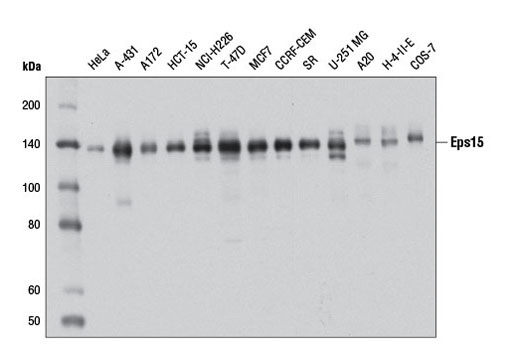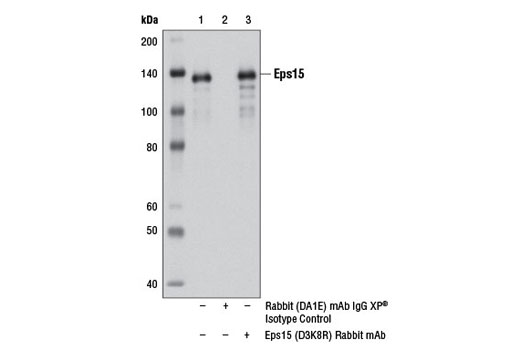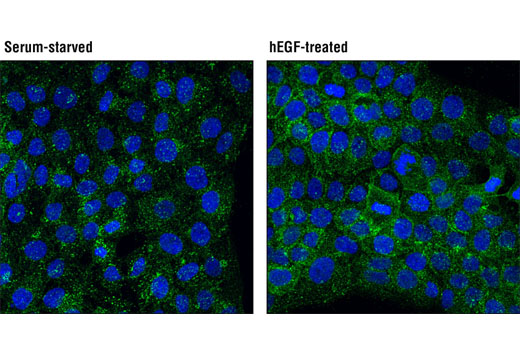WB, IP, IF-IC
H M R Mk
Endogenous
138
Rabbit IgG
#P42566
2060
Product Information
Product Usage Information
| Application | Dilution |
|---|---|
| Western Blotting | 1:1000 |
| Immunoprecipitation | 1:100 |
| Immunofluorescence (Immunocytochemistry) | 1:200 |
Storage
Specificity / Sensitivity
Species Reactivity:
Human, Mouse, Rat, Monkey
Species predicted to react based on 100% sequence homology
The antigen sequence used to produce this antibody shares
100% sequence homology with the species listed here, but
reactivity has not been tested or confirmed to work by CST.
Use of this product with these species is not covered under
our
Product Performance Guarantee.
Chicken, Xenopus, Dog, Horse
Source / Purification
Monoclonal antibody is produced by immunizing animals with a synthetic peptide corresponding to residues surrounding Pro630 of human Eps15 protein.
Background
Eps15 (EGFR pathway substrate 15) was originally discovered as a substrate for the kinase activity of EGFR (1). Eps15 has a tripartite structure comprising an amino terminal portion, which contains three evolutionarily conserved EH protein-protein interaction domains, a central putative coiled-coil region required for constitutive oligmerization, and a carboxy terminal domain containing multiple copies of the amino acid triplet Asp-Pro-Phe that constitute the AP2 binding domain. The carboxy terminal domain also contains two ubiquitin interaction motifs (UIMs), the last of which is indespensible for Eps15 binding to ubiquitin (1). Several lines of evidence support a role for Eps15 in clathrin-mediated endocytosis, including the endocytosis of synaptic vesicles. Eps15 binds to AP2 as well as other proteins involved in endocytosis and/or synaptic vesicle recycling, such as synaptojanin1 and epsin. Furthermore, Eps15 colocalizes with markers of the plasma membrane clathrin-coated pits and vesicles (2). Eps15 regulates the endosomal trafficking of c-Met (3) and EGFR (4), possibly by recruiting the ubiquitinated receptors to the rims of clathrin-coated pits through interaction between the ubiquitin tag and its UIMs.
The EPS15 gene yields two isoforms that are believed to reside in distinct subcellular locations and are thus implicated in different facets of endosomal trafficking (5). Human EPS15 has been mapped to chromosome 1p31-p32, a region displaying several nonrandom chromosomal abnormalities, including deletions in neuroblastoma and translocations in acute lymphoblastic and myeloid leukemias. Research has shown two translocations t(1;11)(p32;q11) are found in rare cases of myeloid leukemia where the Eps15 gene was fused to the HRX gene, resulting in two reciprocal fusion genes (6).
- Fazioli, F. et al. (1993) Mol Cell Biol 13, 5814-28.
- Tebar, F. et al. (1996) J Biol Chem 271, 28727-30.
- Parachoniak, C.A. and Park, M. (2009) J Biol Chem 284, 8382-94.
- Torrisi, M.R. et al. (1999) Mol Biol Cell 10, 417-34.
- Roxrud, I. et al. (2008) J Cell Biol 180, 1205-18.
- Bernard, O.A. et al. (1994) Oncogene 9, 1039-45.
Species Reactivity
Species reactivity is determined by testing in at least one approved application (e.g., western blot).
Western Blot Buffer
IMPORTANT: For western blots, incubate membrane with diluted primary antibody in 5% w/v nonfat dry milk, 1X TBS, 0.1% Tween® 20 at 4°C with gentle shaking, overnight.
Applications Key
WB: Western Blotting IP: Immunoprecipitation IF-IC: Immunofluorescence (Immunocytochemistry)
Cross-Reactivity Key
H: human M: mouse R: rat Hm: hamster Mk: monkey Vir: virus Mi: mink C: chicken Dm: D. melanogaster X: Xenopus Z: zebrafish B: bovine Dg: dog Pg: pig Sc: S. cerevisiae Ce: C. elegans Hr: horse GP: Guinea Pig Rab: rabbit All: all species expected
Trademarks and Patents
使用に関する制限
法的な権限を与えられたCSTの担当者が署名した書面によって別途明示的に合意された場合を除き、 CST、その関連会社または代理店が提供する製品には以下の条件が適用されます。お客様が定める条件でここに定められた条件に含まれるものを超えるもの、 または、ここに定められた条件と異なるものは、法的な権限を与えられたCSTの担当者が別途書面にて受諾した場合を除き、拒絶され、 いかなる効力も効果も有しません。
研究専用 (For Research Use Only) またはこれに類似する表示がされた製品は、 いかなる目的についても FDA または外国もしくは国内のその他の規制機関により承認、認可または許可を受けていません。 お客様は製品を診断もしくは治療目的で使用してはならず、また、製品に表示された内容に違反する方法で使用してはなりません。 CST が販売または使用許諾する製品は、エンドユーザーであるお客様に対し、使途を研究および開発のみに限定して提供されるものです。 診断、予防もしくは治療目的で製品を使用することまたは製品を再販売 (単独であるか他の製品等の一部であるかを問いません) もしくはその他の商業的利用の目的で購入することについては、CST から別途許諾を得る必要があります。 お客様は以下の事項を遵守しなければなりません。(a) CST の製品 (単独であるか他の資材と一緒であるかを問いません) を販売、使用許諾、貸与、寄付もしくはその他の態様で第三者に譲渡したり使用させたりしてはなりません。また、商用の製品を製造するために CST の製品を使用してはなりません。(b) 複製、改変、リバースエンジニアリング、逆コンパイル、 分解または他の方法により製品の構造または技術を解明しようとしてはなりません。また、 CST の製品またはサービスと競合する製品またはサービスを開発する目的で CST の製品を使用してはなりません。(c) CST の製品の商標、商号、ロゴ、特許または著作権に関する通知または表示を除去したり改変したりしてはなりません。(d) CST の製品をCST 製品販売条件(CST’s Product Terms of Sale) および該当する書面のみに従って使用しなければなりません。(e) CST の製品に関連してお客様が使用する第三者の製品またはサービスに関する使用許諾条件、 サービス提供条件またはこれに類する合意事項を遵守しなければなりません。


